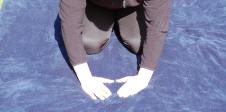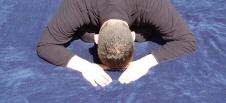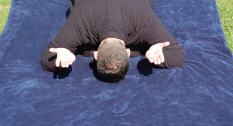Sampai
This text is an excerpt from my book The Secret Book of Zen.
(Note: The images shown here were taken exclusively for this website © 2011 Jan Hendriksson, publication and duplication not allowed)
(...)
An extension of the bow is the prostration, which in Zen is called sampai. You can also combine the gassho and the sampai positions. For example, start with the gassho bow and then go into the sampai position.
How it’s done
From the standing gassho position, sit on your heels, with your knees pointing forward and your feet pointing towards the back. Then place your hands flat on the ground in front of your body, with the palms flat on the ground. With the two thumbs and index fingers almost touching, both of your hands should roughly form a triangle. You must lean your upper body forward and in this way, you bow almost automatically. Lower your head until your forehead almost touches the ground. When doing so, your forehead rests in front of your hands which are positioned on the ground. Then, open your hands and raise them, with the palms upward, on the left and right of your head. Your head continues to rest almost on the ground. Your upper body rests on your thighs, with only your palms lifted upwards towards the ceiling. You are positioned in this prostration with your head facing down and your palms facing up. From this point, things will proceed backwards. You position your hands again in a triangle in front of your head, rise from the prostration, get up and once again stand in the gassho position.
Your palms facing upward are intended to represent the soles of Buddha’s feet. You thereby express that you feel subordinate, with great humility, to the Buddha, his teachings, and also your own Buddha-nature, and want to allow them to guide your life.




